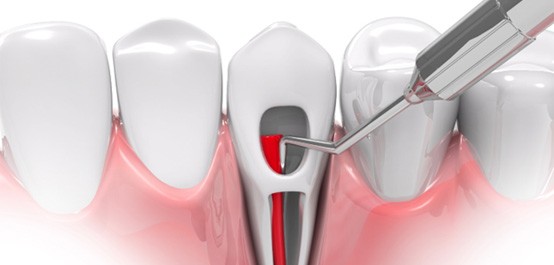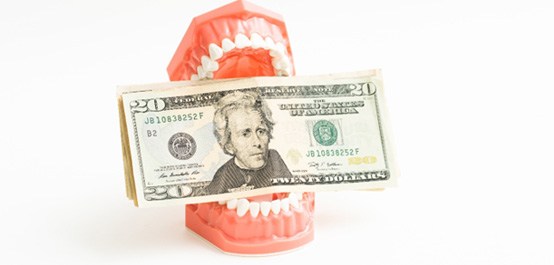Root Canal Therapy – Owasso, OK
A Quick, Gentle Way to Save a Tooth
Root canal therapy isn’t as scary as you think. Today’s modern care techniques and technology have allowed us to minimize discomfort to the point where a root canal causes no more pain than a standard filling. Thus, you won’t have any reason to be afraid to call Dr. Gaches to schedule a consultation when you’re suffering from a toothache that might be linked to an infection of the dental pulp – a condition that requires root canal therapy from our Owasso dentist if you want to save the tooth.
Why Choose Infinite Smiles Dentistry for Root Canal Therapy?
- Advanced Tech for Pain-Free Care
- Patient-Centered Dentist & Staff
- Quality, Personalized Dental Crowns
Do I Need Root Canal Therapy?
A severe, persistent toothache is the most common indication of needing a root canal. However, that’s not the only symptom you should look for. Some other signs to look out for include:
- Extreme sensitivity to hot or cold foods and drinks
- Sharp pain when biting down
- Darkening of a tooth
- Swelling or redness of the gums surrounding a tooth
- A small pimple-like bump develops on the gums near a tooth
If you notice any of these symptoms, contact our office right away for assistance. Our team will get you in for an appointment as soon as possible.
The Root Canal Process
Root canal therapy is performed when a tooth infection has reached the inner pulp. After the tooth has been opened, we carefully remove the infected pulp tissue and detoxify the root canal chamber; the duration of this process depends on the complexity of the tooth’s inner structure. Afterward, the inside of the tooth is filled up, and a crown is placed in order so that you can keep using it to bite and chew normally.
The Benefits of Getting a Root Canal

Preserving your natural tooth structure is always our team’s primary goal. Delaying a root canal when you need one can cause the infection to progress to the point of no return. As a result, your tooth may need to be extracted entirely. The process of removing and replacing a tooth is far more complex, time-consuming, and expensive than root canal therapy.
Aside from saving your natural tooth, getting a root canal will allow you to enjoy the following benefits:
- Virtually pain-free procedure – You’ll be happy to know that advanced dental technology makes getting a root canal about as comfortable as getting a standard filling.
- High success rate – Most root canal patients can keep their treated teeth for decades or even the rest of their lives!
- Aesthetically pleasing results – Following your root canal, your tooth will be restored with a custom-made dental crown. It will seamlessly blend with the rest of your smile, allowing you to enjoy a natural-looking appearance.
Understanding the Cost of Root Canals

Root canals are often something people get because they need to, not because they’d like to. That being the case, people can sometimes be caught off guard not only by the treatment itself, but by the cost of care. We work hard to make sure that every part of the process, including payment, is as easy as possible.
For patients currently trying to navigate the cost of treatment, here’s what you should know.
Factors That Can Affect Root Canal Cost

Unfortunately, one of the things that you’ll find when you start talking to us about your root canal is how many variables are at play. There are several factors that can affect what your root canal cost, including:
- What kind of tooth you’re having treated. Molars have more roots than bicuspids, which have more than incisors.
- Whether you need a dental crown after the treatment, and what you want the crown to look like.
- How difficult or complex your root canal will be.
- Whether you need to deal with an external specialist.
Is it Cheaper to Pull My Tooth?

While simply removing a tooth might be cheaper than a root canal at first, you’re left with an empty spot in your mouth that you’re going to need to fill. If you don’t, other teeth could start to slide out of alignment and that area of the jaw could be reabsorbed into the body.
When you account for the necessary dental bridge, denture, or dental implant that follows a tooth extraction, the root canal is actually often the more affordable option.
Does Dental Insurance Cover Root Canals?

Root canals are a major medical procedure only done when absolutely necessary. That being the case, most dental plans will cover at least some of the treatment, typically around 50-80% of the final cost. Every plan is different however, so we’ll help to confirm with your insurance company how much coverage you can expect.
Other Options for Making Root Canal Treatment Affordable

Even if you don’t have dental insurance, there are options available to ensure that you can afford the care you need.
For one, we have an in-house membership plan. For a flat annual fee, you can get complimentary x-rays, exams, and 20% off crowns/fillings. This can take a lot of the financial pressure away from a root canal treatment by making accompanying treatments more affordable.
We also often work with CareCredit, a financing firm that offers low interest terms to patients who qualify. This can alleviate the burden of having to pay for care all at once.
There’s no reason to suffer. If you have a serious toothache, give us a call and we’ll find financial options that will work for you.
Root Canal FAQs
Can I Eat Before a Root Canal?
Whether you can eat before a root canal depends on your case. After all, different patients have varying needs. You should thus consult your dentist to learn the details. (The exception is alcohol, as it should be avoided for 24 hours before the procedure.)
For example, perhaps you’ll be sedated for your root canal. The dentist may then ask you to fast for a few hours beforehand. That way, you’ll reduce the risk of nausea during treatment.
If you don’t undergo sedation, things change. You could have a healthy meal a couple of hours before the procedure. Since your mouth will be numb after it, eating post-care would be tricky for a while.
How Much Pain is Normal After a Root Canal?
To be clear, the root canal itself shouldn’t hurt. Your procedure ought to be smooth and painless. That said, it’s normal to feel sore over the next few days.
Remember, the root canal’s numbing effect will wear off. You’ll likely feel mild pain and sensitivity once it does. Still, this ache should be temporary and fade quickly. You can also manage it with over-the-counter pain relievers and a cold compress.
Of course, be careful during the recovery period. Habits like chewing hard food could worsen the discomfort. Also, contact us if the pain doesn’t fade after three days.
How Long Does it Take to Recover from a Root Canal?
It often doesn't take long to recover from a root canal. In fact, many patients are well enough to attend work or school the day after. However, the exact timing differs for everyone.
If your job involves physical labor, you’ll likely need two or three days off. Vigorous exercise would divert blood from the treatment site. Should that happen, the healing process will take longer.
To ensure fast recovery, you’ll also need to be cautious. Only eat soft foods during this period and chew on the side opposite your root canal. Similarly, brush or floss gently when cleaning near the treated tooth. If your pain worsens after three days, call us at once.
Do Root Canals Ever Have to Be Redone?
Luckily, root canals have a high success rate. They tend to work properly in the long run. Even so, your procedure may well need redoing at some point.
You see, root canal re-treatments are done for various reasons. Saliva might contaminate the tooth during your procedure. Alternatively, maybe the permanent crown was placed too long after the therapy. If the tooth had more root canals than expected, the dentist might not have disinfected all of them.
